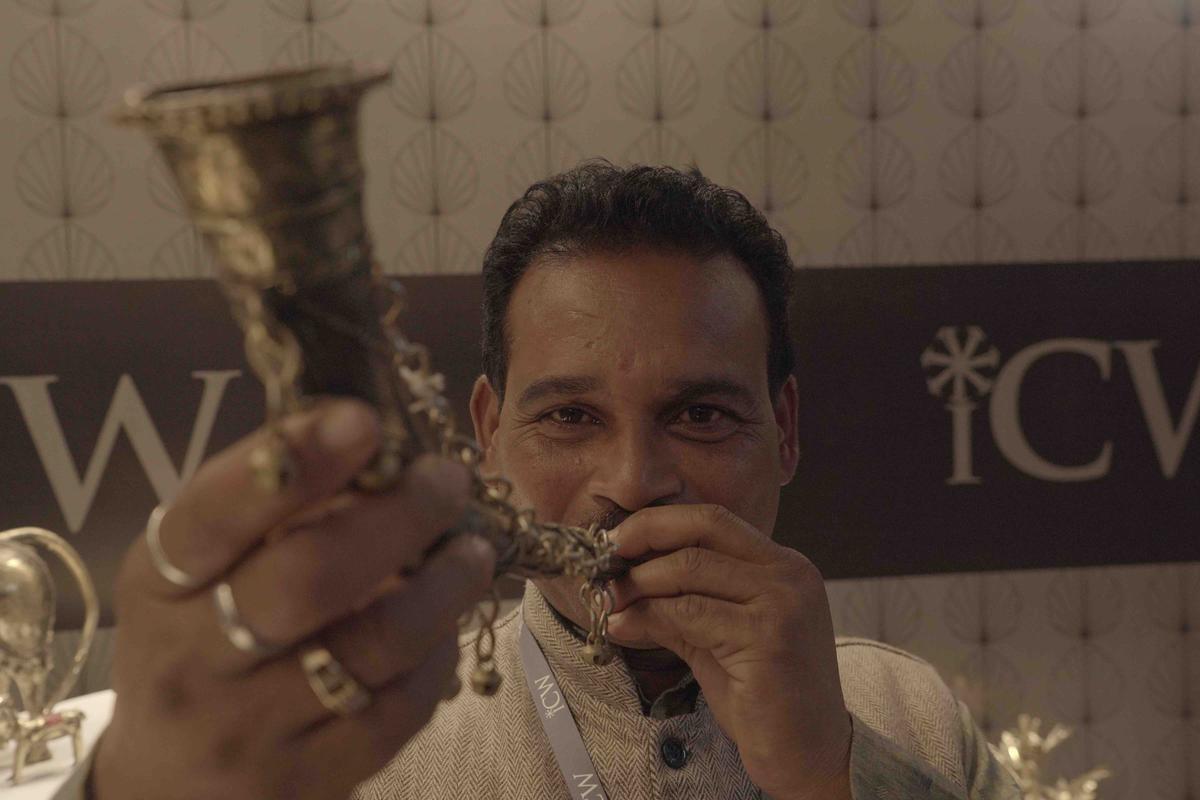The fourth edition of India Craft Week is a journey in continuation to bring together the Indian creators of rare arts and crafts of India and the connoisseurs from across the world
The fourth edition of India Craft Week is a journey in continuation to bring together Indian creators of rare arts and crafts and connoisseurs from across the world
It is not often that one gets to see or buy a signature Rogan art product made by Padma Shri awardee Abdul Gafur Khatri. Rogan, the fine ancient Persian art is exclusive to his family in Nirona village in Kutch, Gujarat, and can be bought only from them directly. For instance, you won’t find a Rogan sari, which has the stamp of Gafur’s talent, which won him the National Award in 2019, in any fair or market.
“Our drawing is our legacy,” says Gafur, now in Delhi to participate in the fourth chapter of the India Craft Week (ICW), supported by the World Crafts Council. It is bigger than previous years in terms of the size of the venue, participation and unique sections added to the event.
“The craft sector needs an axis shift from ‘not for profit’ to ‘for profits’, given the exquisite work our master artisans produce,” says Iti Tyagi, founder of ICW. “The objective is to bring rural talent to the fore and get business and international projects for our traditional hand-crafted works by connecting those with modern and global consumers,” she adds.
Abdul Gafur Khatri, the upholder of Rogan art in his village Nirona in Kutch district
| Photo Credit: Special Arrangement
Gafur has attended the ICW since its inception in 2018, and is among the 75 artists and 50 crafts persons participating this year. He says the platform provides him an opportunity to showcase Rogan textile art to a larger audience that appreciates art.
Rogan art is done on poplin cotton or silk using thick shiny paint that is made by heating castor oil and mixing the residue with cold water till it thickens into a sticky paste called Rogan. To this are added natural vegetable colour pigments. Elaborate designs are produced freehand by trailing thread-like strands of paint with a stylus. When half of a design is painted, the cloth is folded in half to transfer a mirror image to the other half of the fabric.
Floral motifs, animals and local folk art lead the designs that flow from imagination. “It is the artist’s imagination on the cloth. There is no tracing or sketching and no drawings are referred to,” says Gafur, who is credited with the resurgence of the art form in the early eighties, after it faced extinction in the wake of consecutive years of drought in his village five decades ago. He has been instrumental in training and awakening the interest in his village to revive Rogan art. Ten of his relatives, including his son, who is the eighth generation, also pursue the art.

Khwaja Nazir Ali, Sozni craftsperson
| Photo Credit: Special Arrangement
J&K State awardee Khwaja Nazir Ali from Srinagar is a fourth generation master craftsperson of the 500-year-old Sozni embroidery. One of his ultra-luxe creation, a pashmina shawl with silk thread embroidery on both sides, took him seven years to complete. It was like a meditation, he says. The popular needle-point technique is one of the rarest embroidery forms with which the craftspersons create stunning compositions.
“At ICW, we display exclusive and original crafts. It is a vibrant meeting point with crafts-loving people genuinely appreciating our skills and the beauty and value of our products,” he says.

Rajendra Baghel Dhokra artisan from Chattisgarh at ICW
| Photo Credit: Special Arrangement
National Award winner in Dhokra sculptures made in non-ferrous metal casting, Rajendra Baghel from Kondagaon in Bastar, Chattisgarh is another regular participant at ICW. The products of dhokra artisans are in great demand in domestic and foreign markets, he says, because of its simplicity, enchanting folk motifs and powerful forms. His Dhokra horses, elephants, peacocks, owls, religious images, measuring bowls and lamp caskets have earned him name and fame. He has trained more than 200 people in his village to keep the craft alive and evolving. He finds ICW an invigorating experience as visitors come looking for original and authentic art and craft works. It has also given him the opportunity to take his exhibition to USA, Russia, England, Scotland.

Ceramic art by National Award winner from Mumbai, Shailesh Pandit, at ICW
| Photo Credit: Special Arrangement
Somesh Singh- Co-Founder, Craft Village, a Delhi-based social organisation that conducts the ICW, says, “Many things have changed post-COVID and our master artisans have to be future-ready without losing the real essence of their crafts that are a mirror of our cultural identity. Through our curated experiences, we envision to create a harmonious ecosystem for Master craftspersons, craftpreneurs and consumers by engaging them in a dialogue and redefining conventional businesses.”
The India Craft Week 2022 is on till October 24 at NSIC ground, Okhla; 11 am to 6 pm


